最新Parkour跑酷全面详细英文介绍.ppt
- 格式:ppt
- 大小:929.50 KB
- 文档页数:12
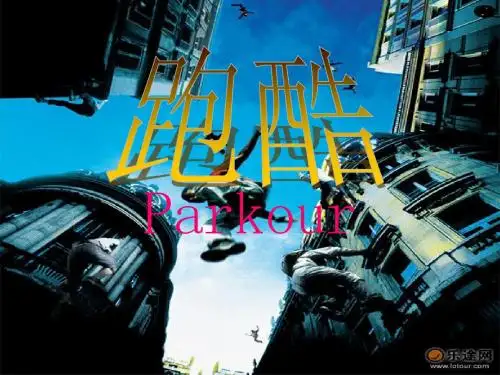
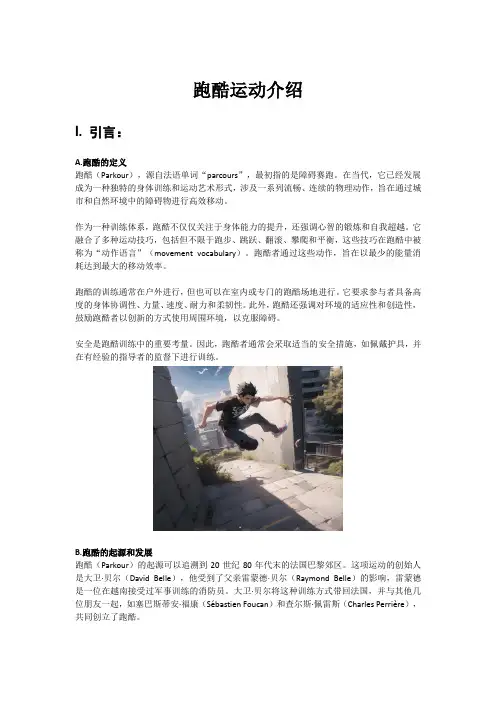
跑酷运动介绍I. 引言:A.跑酷的定义跑酷(Parkour),源自法语单词“parcours”,最初指的是障碍赛跑。
在当代,它已经发展成为一种独特的身体训练和运动艺术形式,涉及一系列流畅、连续的物理动作,旨在通过城市和自然环境中的障碍物进行高效移动。
作为一种训练体系,跑酷不仅仅关注于身体能力的提升,还强调心智的锻炼和自我超越。
它融合了多种运动技巧,包括但不限于跑步、跳跃、翻滚、攀爬和平衡,这些技巧在跑酷中被称为“动作语言”(movement vocabulary)。
跑酷者通过这些动作,旨在以最少的能量消耗达到最大的移动效率。
跑酷的训练通常在户外进行,但也可以在室内或专门的跑酷场地进行。
它要求参与者具备高度的身体协调性、力量、速度、耐力和柔韧性。
此外,跑酷还强调对环境的适应性和创造性,鼓励跑酷者以创新的方式使用周围环境,以克服障碍。
安全是跑酷训练中的重要考量。
因此,跑酷者通常会采取适当的安全措施,如佩戴护具,并在有经验的指导者的监督下进行训练。
B.跑酷的起源和发展跑酷(Parkour)的起源可以追溯到20世纪80年代末的法国巴黎郊区。
这项运动的创始人是大卫·贝尔(David Belle),他受到了父亲雷蒙德·贝尔(Raymond Belle)的影响,雷蒙德是一位在越南接受过军事训练的消防员。
大卫·贝尔将这种训练方式带回法国,并与其他几位朋友一起,如塞巴斯蒂安·福康(Sébastien Foucan)和查尔斯·佩雷斯(Charles Perrière),共同创立了跑酷。
跑酷的发展受到了多种文化的影响,包括武术、体操、舞蹈和街头艺术。
它不仅是一种身体训练,也是一种精神实践,强调自由、自我表达和对环境的深刻理解。
随着时间的推移,跑酷逐渐从法国传播到世界各地,成为一种全球性的现象。
在21世纪初,跑酷开始出现在主流媒体中,特别是在电影、电视节目和视频游戏中。
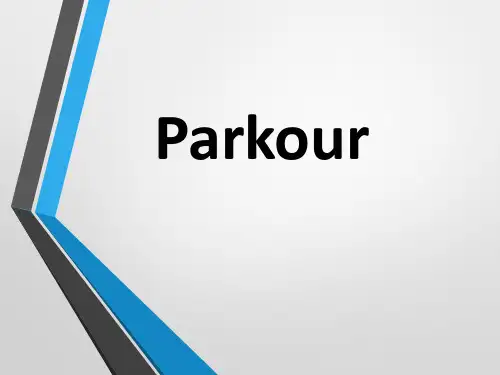
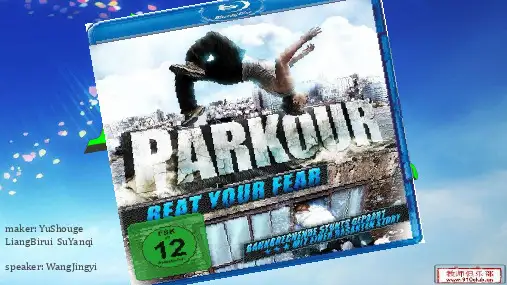
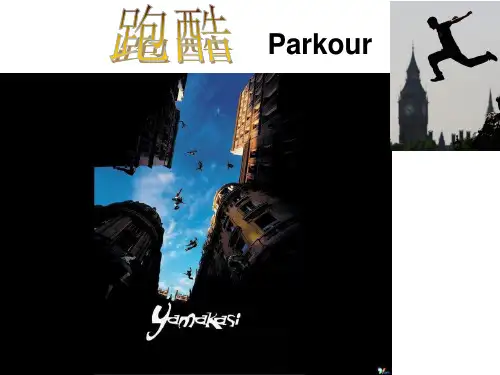
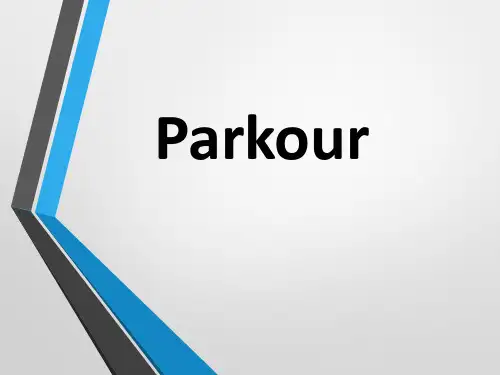
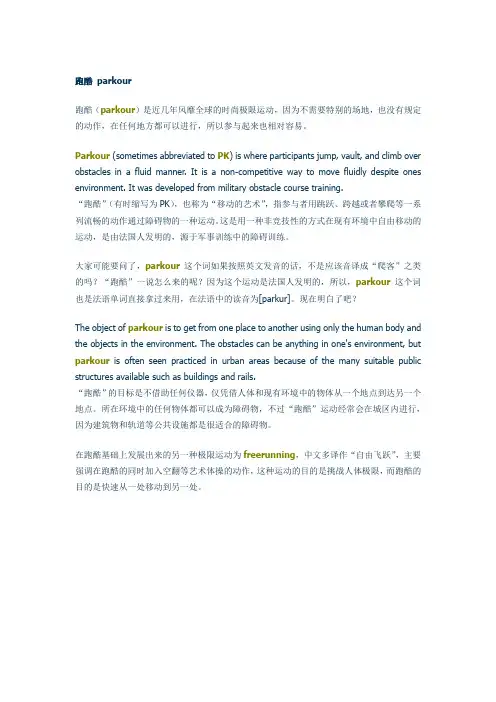
跑酷parkour跑酷(parkour)是近几年风靡全球的时尚极限运动,因为不需要特别的场地,也没有规定的动作,在任何地方都可以进行,所以参与起来也相对容易。
Parkour (sometimes abbreviated to PK) is where participants jump, vault, and climb over obstacles in a fluid manner. It is a non-competitive way to move fluidly despite ones environment. It was developed from military obstacle course training.“跑酷”(有时缩写为PK),也称为“移动的艺术”,指参与者用跳跃、跨越或者攀爬等一系列流畅的动作通过障碍物的一种运动。
这是用一种非竞技性的方式在现有环境中自由移动的运动,是由法国人发明的,源于军事训练中的障碍训练。
大家可能要问了,parkour这个词如果按照英文发音的话,不是应该音译成“爬客”之类的吗?“跑酷”一说怎么来的呢?因为这个运动是法国人发明的,所以,parkour这个词也是法语单词直接拿过来用,在法语中的读音为[parkur]。
现在明白了吧?The object of parkour is to get from one place to another using only the human body and the objects in the environment. The obstacles can be anything in one's environment, but parkour is often seen practiced in urban areas because of the many suitable public structures available such as buildings and rails.“跑酷”的目标是不借助任何仪器,仅凭借人体和现有环境中的物体从一个地点到达另一个地点。
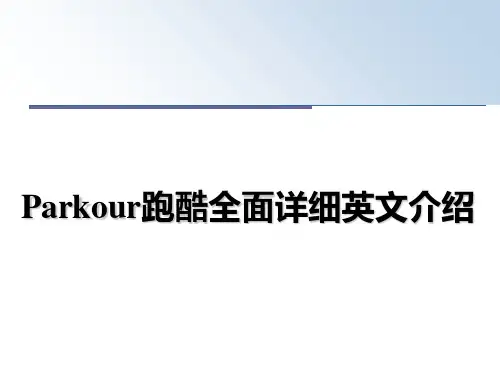
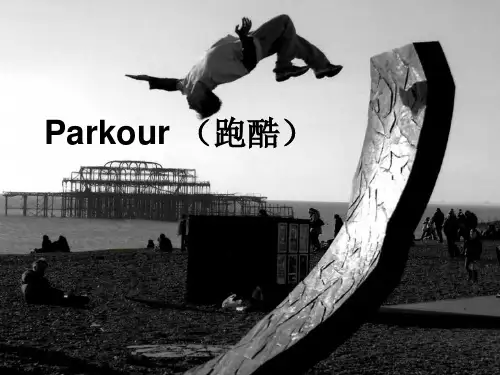


Parkour,中文称“跑酷”,把整个城市当做一个大训练场,一切围墙、屋顶都成为可以攀爬、穿越的对象,特别是废弃的房屋。
跑酷是一项街头疾走极限运动,要求速度和实用性,配合猿猴一样的灵活攀越。
不过这项运动的热衷者倒更愿意把它看成是一种青年亚文化所倡导生活方式。
它帮助你只用本身的力量穿越任何障碍物,或到达一个目的地。
跑酷不仅是门运动的艺术,也是一种生活方式,跑跳攀爬中的自由灵魂在运动中无限伸展。
在跑酷的世界里,练习者称为Traceur,所有Traceur参与这项运动前一定要经过专业训练。
Where did it come from?跑酷确切的起源,并不是非常清晰。
但是最初是由越战中的法国士兵们发起,2002年在英国开始盛行,后来大卫·贝尔把它发扬光大。
法国电影《暴力街区》(Banlieue13)即是展示跑酷街头文化,主角DAVID BELLE是该运动的创始人之一。
Parkour(常常被缩写为PK)or l’art du déplacement(移动的艺术)is both a discipline1with the aim of moving from one point to another as smoothly,efficiently and quickly as possible using principally the abilities of the human body,but is also built on a philosophical premise,perhaps more similar to martial arts than to a sport such as gymnastics.Parkour’s focus is on how any obstacle is dealt with,whether the obstacle is either physical or mental.HistoryInspiration for parkour came from many sources, the foremost being the“Natural Method of Physical Culture”developed by Georges Hébert in the early twentieth century.French soldiers in Vietnam were inspired by Hébert’s work and created what is now known as parcours du combattant(军队障碍训练课程).David Belle had participated in activities such as martial arts and gymnastics,and sought to apply his athletic prowess2in a manner that would have practical use in life.After moving to Lisses commune3,David Belle continued his journey with others.“From then on we developed,”says Sébastien Foucan—a childhood friend of David Belle,who helped to spread parkour—in Jump London,“And really the whole town was there for us;there for parkour.You just have to look,you just have to think,like children.”This,as he describes,is“the vision4of parkour”.Over the years as dedicated practitioners improved their skills,their moves continued to grow in magnitude5,so that building-to-building jumps and drops of over a story became common in media portrayals6,often leaving people with a slanted7view on the nature of parkour.The journey of parkour from the Parisian suburbs to its current status as a widely practiced activity outside of France created20跑P a r k o u r酷方看★★★★OVERSEAS ENGLISHsplits8among the originators.Risk-takers or Self-challengers?跑酷究竟是冒险还是自我挑战,还是自我价值的实现需求,这些都已不重要,重要的是,运动的人很快乐,乐在这种冒险中,乐在这种刺激中,乐在这种挑战中!Although many core practitioners would deny that parkour is an extreme sport,it does carry inherent9risk with it.The practice of running, jumping,and leaping from a variety of urban structures(e.g.,roof tops,staircases,raised surfaces, walls,etc...)and landing on concrete,of course, carries the potential for injury.Some of the most common injuries among practitioners who do not undergo the necessary conditioning10prior11to such practise include sprained12ankles and repetitive strain injuries to the knees.However,excessive risk-taking runs in opposition to the philosophy13of parkour.According to one participant,“one of the most striking differences between parkour and other so-called‘extreme’sports is that it is not concerned solely with the acquisition of physical skills,but also with the improvement of one’s mental and spiritual well-being.Ensuring that physical progress is not at the expense of mental progress is one of the main aims of a good traceur”.The experienced traceurs do not engage in the activity in order to experience the adrenaline-rush14 that comes from excessive risk-taking.Rather,they view their practise as challenging themselves to overcome limitation and the restraints of fear and inhibition.The goal of complete functionality within any situation is paramount15,and in order to achieve this state both mentally and physically it is necessary to face and overcome the challenges that are part and parcel of parkour training.Moving swiftly on...未来跑酷的前景又是什么呢?虽然不太可能成为主流运动,但是它的追逐者们不会就此放弃,依然会继续非主流地运动着!In its fairly short public lifespan to date there hasbeen enormous interest from a host of large organisations.Parkour has eased itself stealthily fromthe underground shadows of Paris to the gritty16 streets of London and from there on to the glamorous world stage itself.And now it is even beginning to filter into17that most mainstream of institutions—Education:In early2006Westminster Council enlisted the services of two parkour instructors in Francois“Forrest”Mahop and Dan Edwardes of Parkour Generations to teach the discipline within several inner-city schools and community sports centres.The groundbreaking18 project has been a huge success and has gone from strength to strength,with local councils all over the country now desperate to reproduce that which Westminster has pioneered.Westminster has also sponsored the establishment of the Parkour Generations Academy at Moberly Sports Centre in northwest London,which occurs weekly and is run by those same instructors,with every class regularly attended by over60 students.It certainly can no longer be described as an underground activity,it seems.The movement is still relatively young(or as oldas sin,depending on how you look at it!),and whereit goes from here is very much in the hands of the people who live and breathe it—the practising community and its spokespeople.Parkour has nowbeen involved in several big-budget movies,and traceurs have appeared all over the world,from Brazilto Japan,from Finland to Australia,from Russia to Canada.211.discipline锻炼方式,训练方法,运动2.prowess[′pra尬is]高超技艺;非凡的才能;专长mune[′k鬑mju蘼n](法国、比利时、意大利、西班牙的)最小地方行政区(有市长和地方议会)4.vision[′vi廾藜n]愿想;理念,远见5.magnitude[′m覸弈nitju蘼d]规模,难度6.portrayal[p蘅蘼′trei藜l]描述,描绘,表现7.slanted[′sl藁蘼ntid]有偏见的8.split[split]分离,分裂9.inherent[in′hi藜r藿nt]内在;固有的;本来的10.conditioning[k藜n′di蘩藜ni耷]准备活动,准备措施11.prior[′prai藜]在……之前12.sprained[s preind]ankles[′覸耷klz]脚踝扭伤13.philosophy[fi′l鬑s藜fi]原则14.adrenaline[藜′dren藜lin]肾上腺素adrenaline-rush肾上腺素分泌量猛增15.paramount[′p覸r藜ma尬nt]最重要的;最重大的;至上的16.gritty[弈riti]多沙的17.filter[′filt藜](into)慢慢传开;渗透18.groundbreaking创造性的;革新的注释:看方西。
Parkour is the art of moving through your environment using only your body and the surroundings to propel yourself. It can include running, jumping, climbing, even crawling, if that is the most suitable movement for the situation. Parkour could be grasped by imagining a race through an obstacle course; the goal is to overcome obstacles quickly and efficiently, without using extraneous movement. Apply this line of thought to an urban environment, or even a run through the woods, and you're on the right path. Because individual movements could vary so greatly by the situation, it is better to consider Parkour as defined by the intention instead of the movements themselves. If the intention is to get somewhere using the most effective movements with the least loss of momentum, then it could probably be considered Parkour.What isn't Parkour?Parkour is not acrobatics, tricking, stunts, recklessness, or jumping off high objects for no reason. It is not any movement or activity that doesn't fit in the above description "What Parkour Is". It is also not "What you make of it" ... it is predefined and has a purpose, if something doesn't suit that purpose, it is not Parkour.What is Free Running?Free running was meant to start out an anglicized term for Parkour. It was first suggested to Sebastien Foucan during the filming of Jump London. Free Running has grown to be descriptive of a sort of "cousin" activity to Parkour - Free Running is more expressive and creative in nature, with moves such as acrobatics, flips, and spins added for flair, creativity, or just because someone wants to. The main difference then between Parkour and Free Running is that Parkour is defined by purpose "get somewhere quickly and efficiently using the human body", and Free Running is defined by the activity or art of moving through your environment however you want, moving your way, following your own path.跑酷亦称作“城市疾走”,即Parkour,常简称为PK,诞生于80年代的法国,有“超越障碍训练场”的意思。
城市疾走攀爬简介:跑酷Parkour,又称为城市疾走、Le Parkour,是一种“超越障碍训练”的街头文化,也是一种极限运动。
跑酷最初由越战中的法国士兵们发起,2002年在英国开始盛行,法国演员大卫·贝尔开创出Parkour运动。
跑酷把整个城市当作一个大训练场,一切围墙、屋顶都成为可以攀爬、穿越的对象,特别是废弃房屋的街头疾走极限运动,具有观赏性。
运动起源:“跑酷”最初由20世纪80年代越战中的法国士兵们发起,2002年在英国开始盛行,后来法国的大卫·贝尔David Belle把它发扬光大。
法国电影《Banlieue13》暴力街区13区即是展示Parkour街头文化,电影主角大卫·贝尔是LE Parkour运动的创始人之一。
跑酷常被归类为一种极限运动,以日常生活的环境多为城市为运动的场所;并没有既定规则,做运动的人只是把各种日常设施当作障碍物或辅助,在其间跑跳穿行。
创始人:城市疾走创办人是大卫·贝尔,出生于法国。
他的父亲是一位军人,受到父亲的启发,大卫·贝尔开创出Parkour运动。
Sebastian Foucan,是大卫·贝尔的好友,他们一起开发出Parkour理念,创造出一种新的生活方式。
Sebastian Foucan受到亚洲哲学的影响,决定要把跑酷本身的信念从对抗负面力量转换成“像水一样的流动”,成为建立Parkour思想的开创人。
运动特点:跑酷是具有观赏性的城市疾走、街头疾走极限运动,类似于Free-running,区别在于Free-running讲求表演、观赏性,跑酷则是速度、实用性。
跑酷是一门艺术,运动的热衷者把它看成是一种青年亚文化所倡导生活方式。
跑酷不只对身体有利,思想也很重要的。
练习跑酷时需要非常专注,让练习者明白怎么克服自己的恐惧和加强克服困难的能力,不断提升自己突破障碍的能力。
跑酷能使人通过敏捷的运动来增强身心对紧急情况的应变能力,和武术近似。